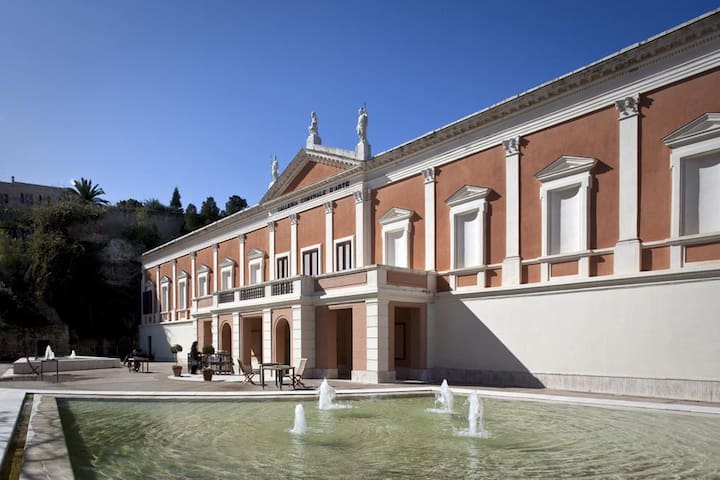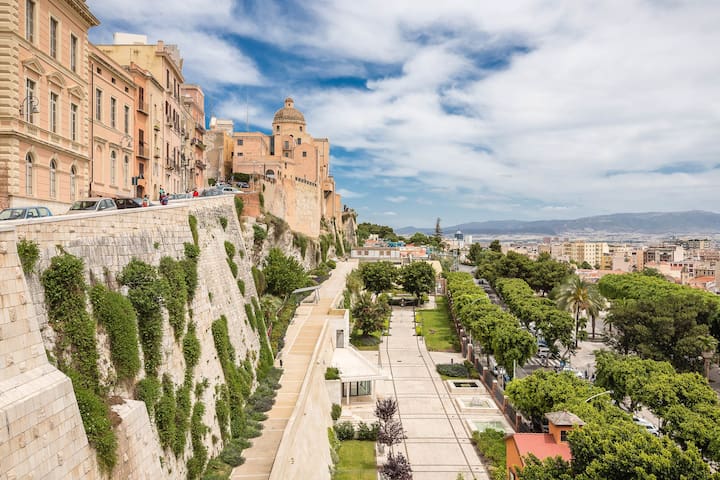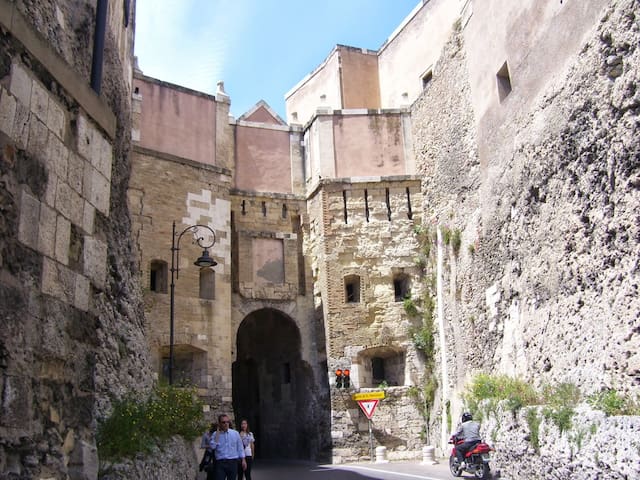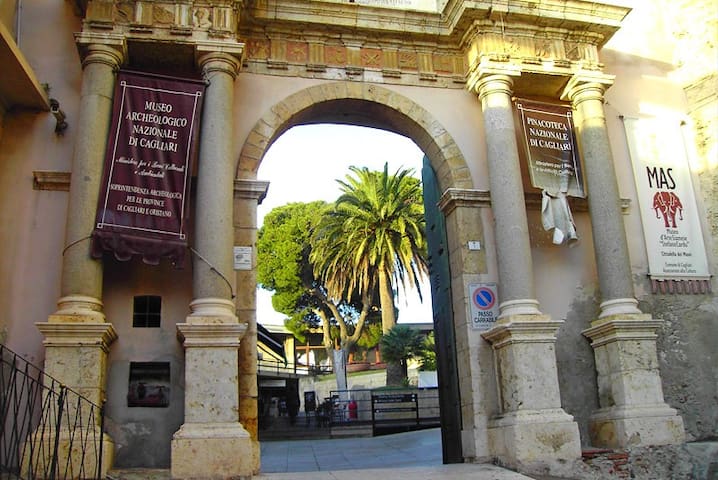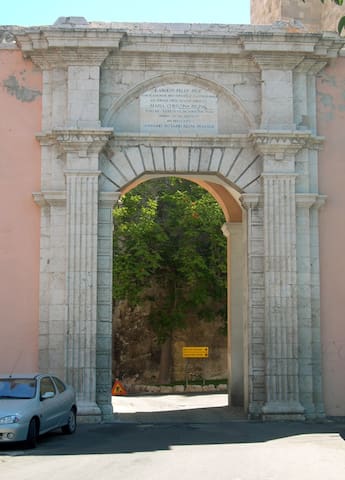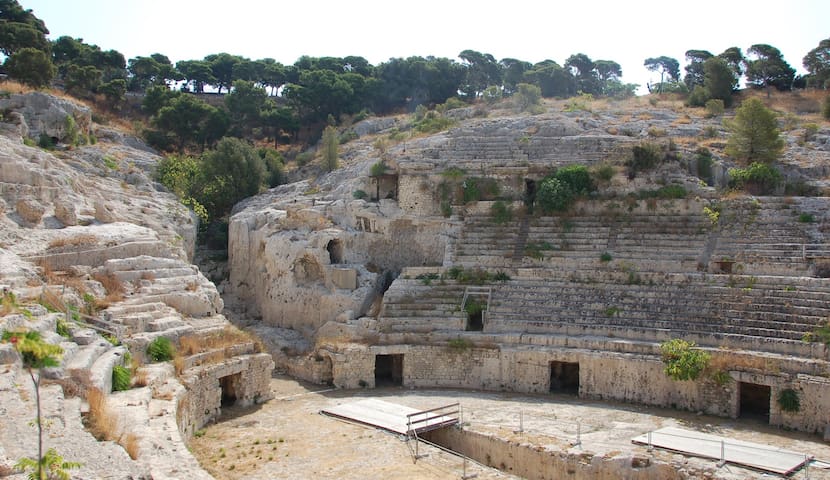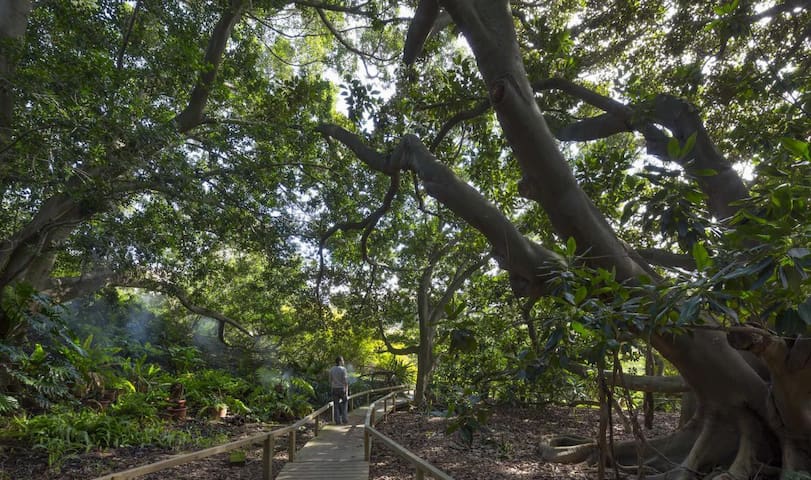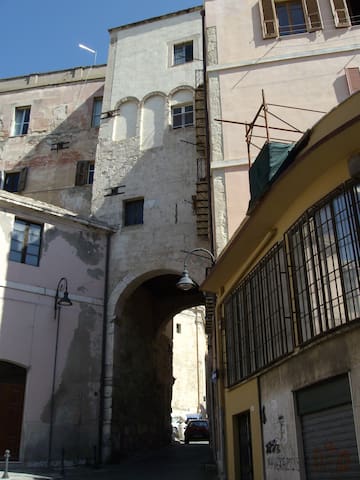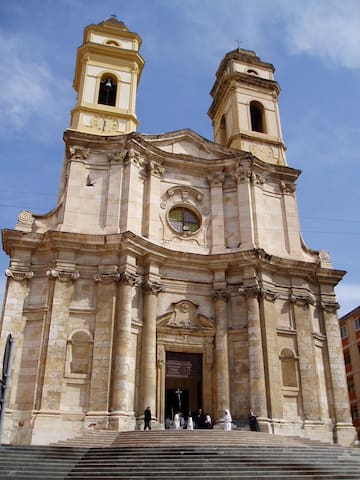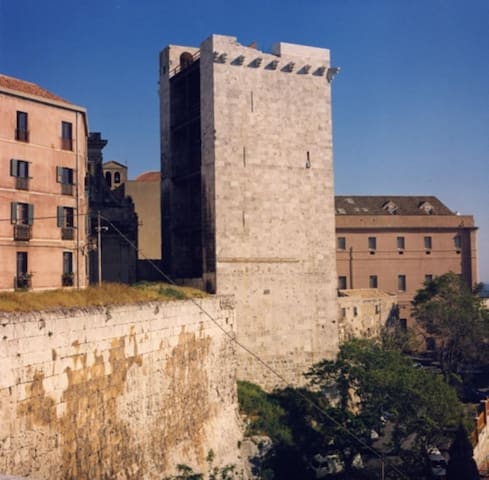Walking Cagliari
This is a walking route that will allow you to explore the sightseeings around our apartment La Casetta.
We're lucky enough to have an apartment in the city center and it's an area with a deep history that lies just below its surface of bustling shopping streets, cafes and restaurants.
With this guide you will be able to see your surroundings with the eyes of a local resident and with the constant option to deviate from it and dive deeper, should you want to do so at any point.
If you had one day in Cagliari and you'd want to know the landmarks that provide the city with its identity, this is a walk you don't want to miss having.
To do it, you just need the will to enjoy your day and a desire to go a bit deeper in knowing this beautiful city!
Piazza Costituzione (Constitution’s square) is an important intersection for those who want to know Cagliari. Besides it being the ending point of a walk in one of the most distinctive streets in Cagliari (Viale Regina Margherita), it lays right in between Via Manno and Via Garibaldi, two busy shopping streets.
Piazza Costituzione also houses the “Antico Caffè 1855”. This bar was established in 1838 by Lazzaro Canepa, a gentleman from Lavagna (Liguria, Italy). In 1855 it was renovated and its name changed to “Caffè Genovese”. In the following years it served as a meeting spot for major italian artists: from the Nobel prize Grazia Deledda, to the authors Salvatore Quasimodo and Gabriele D’Annunzio. Today it still provides a place for aggregation and, thanks to a deep work of restoration which took place in 1998, it provides a window into history and into the city’s culture.
Talking about reasons to reach Piazza Costituzione, we can’t avoid to mention the majestic entrance to Saint Remy’s Bastion. Built at the tail end of the XIX century, it was conceived to connect three previously built bastions: Zecca’s, Spur’s and Saint Catherine’s. It provides a quick (although steep) way to connect the Villanova neighbourhood (below) to the Castello district (above).
In 1943, right before WWII’s end, the allies proceeded to bomb Cagliari. The result was catastrophic and more than 75% of the city's buildings got either completely destroyed or compromised to the point where they had to be taken down. Saint Remy’s Bastion was not spared and suffered enormous damage. Only thanks to a campaign of restoration that took place in the following decade the Bastion could go back to its original form, as it stands today.
Piazza Costituzione
Piazza CostituzionePiazza Costituzione (Constitution’s square) is an important intersection for those who want to know Cagliari. Besides it being the ending point of a walk in one of the most distinctive streets in Cagliari (Viale Regina Margherita), it lays right in between Via Manno and Via Garibaldi, two busy shopping streets.
Piazza Costituzione also houses the “Antico Caffè 1855”. This bar was established in 1838 by Lazzaro Canepa, a gentleman from Lavagna (Liguria, Italy). In 1855 it was renovated and its name changed to “Caffè Genovese”. In the following years it served as a meeting spot for major italian artists: from the Nobel prize Grazia Deledda, to the authors Salvatore Quasimodo and Gabriele D’Annunzio. Today it still provides a place for aggregation and, thanks to a deep work of restoration which took place in 1998, it provides a window into history and into the city’s culture.
Talking about reasons to reach Piazza Costituzione, we can’t avoid to mention the majestic entrance to Saint Remy’s Bastion. Built at the tail end of the XIX century, it was conceived to connect three previously built bastions: Zecca’s, Spur’s and Saint Catherine’s. It provides a quick (although steep) way to connect the Villanova neighbourhood (below) to the Castello district (above).
In 1943, right before WWII’s end, the allies proceeded to bomb Cagliari. The result was catastrophic and more than 75% of the city's buildings got either completely destroyed or compromised to the point where they had to be taken down. Saint Remy’s Bastion was not spared and suffered enormous damage. Only thanks to a campaign of restoration that took place in the following decade the Bastion could go back to its original form, as it stands today.
Saint Remy’s Bastion was built between 1899 and 1902, unifying the previously built Spur’s, Saint Catherine’s and Mint’s bastions.
After being hit by the bombs in 1943 it was restored in the following decade and, in the past few years, it rightfully reached the best shape it has ever been in, in the last 30 years, becoming a place to meet for locals and tourists alike. Its square up top has been dedicated to D.H. Lawrence, a famous english writer who spent time in the city.
The square offers a panoramic view that helps to familiarise with the city’s geography. From here you will be able to spot the port, the Devil’s Seat hill (Sella del Diavolo, in italian), Molentargius’ ponds (a natural park that hosts perennial colonies of pink flamingos) and Urpinu hill (Monte Urpinu, in italian). From here you can also see the most of the bell towers.
Besides its architectural beauty and the night life, it has recently been under the spotlight for archeological findings. From Lawrence Square looking at the stairs that go up to Goffredo Angioni’s Square upstairs, you may notice that the steps are not particularly well kept, and the right hand flight it's closed. Although the whole Bastion has been recently under maintenance and restoration, those stairs have a major humidity issue and it shows from the displacement of the steps. The source of the problem is a tank built during roman times contained between the two flights. It caused humidity and structural issues for years but it was only discovered about 10 years ago, digging in Goffredo Angioni’s square above. Not only it still collects and retains water (hence the humidity issues), but, inside, researchers found relics and finds left by the romans.
At night the Bastion’s square offers long walks, a place to meet and hang out, music (thanks to the Caffè degli Spiriti bar) as well as rare spontaneous concerts held right on the square, without any stage.
316 Recomendado por los habitantes de la zona
Bastión de Saint Remy
Piazza CostituzioneSaint Remy’s Bastion was built between 1899 and 1902, unifying the previously built Spur’s, Saint Catherine’s and Mint’s bastions.
After being hit by the bombs in 1943 it was restored in the following decade and, in the past few years, it rightfully reached the best shape it has ever been in, in the last 30 years, becoming a place to meet for locals and tourists alike. Its square up top has been dedicated to D.H. Lawrence, a famous english writer who spent time in the city.
The square offers a panoramic view that helps to familiarise with the city’s geography. From here you will be able to spot the port, the Devil’s Seat hill (Sella del Diavolo, in italian), Molentargius’ ponds (a natural park that hosts perennial colonies of pink flamingos) and Urpinu hill (Monte Urpinu, in italian). From here you can also see the most of the bell towers.
Besides its architectural beauty and the night life, it has recently been under the spotlight for archeological findings. From Lawrence Square looking at the stairs that go up to Goffredo Angioni’s Square upstairs, you may notice that the steps are not particularly well kept, and the right hand flight it's closed. Although the whole Bastion has been recently under maintenance and restoration, those stairs have a major humidity issue and it shows from the displacement of the steps. The source of the problem is a tank built during roman times contained between the two flights. It caused humidity and structural issues for years but it was only discovered about 10 years ago, digging in Goffredo Angioni’s square above. Not only it still collects and retains water (hence the humidity issues), but, inside, researchers found relics and finds left by the romans.
At night the Bastion’s square offers long walks, a place to meet and hang out, music (thanks to the Caffè degli Spiriti bar) as well as rare spontaneous concerts held right on the square, without any stage.
At the end of Queen Helen’s Boulevard (Viale Regina Elena) it’s possible to take a break in the public gardens of Saint Vincent. A green and peaceful space mostly favoured by local residents. Throughout the gardens you will find sculptures that span from the romans to contemporary times. At the end of the central tree-lined avenue you can visit the city’s communal Gallery of Art.
The building, at first, was a warehouse for ammunition and gunpowder, built in the XVIII century. After its use and a following state of neglect, it was assigned for restoration to Ubaldo Badas, a prominent architect in Cagliari’s history. He led both the restoration and the modernisation, and, in 1933, the building was destined to its current use.
Part of the collection of art pieces, are sculptures from Francesco Ciusa (an artist after which a street in Cagliari is named), works from Umberto Boccioni, Balla, Sironi, Carrà and more. The collection houses a conspicuous amount of contemporary pieces from the 1960s and 1970s.
This space provides a representation of the different influences and the cultural openness to foreign cultures and movements that Cagliari (and Sardinia as a whole) has always had.
Part of the exhibitions are also some caverns located to the left (looking at the building’s entrance from outside). They are artificial caves that were dug in the middle age and they have been used during WWII to provide shelter and protection to the local residents during bombings. Today they host temporary art exhibitions.
39 Recomendado por los habitantes de la zona
Galleria Comunale D'Arte Moderna
2 Viale S. VincenzoAt the end of Queen Helen’s Boulevard (Viale Regina Elena) it’s possible to take a break in the public gardens of Saint Vincent. A green and peaceful space mostly favoured by local residents. Throughout the gardens you will find sculptures that span from the romans to contemporary times. At the end of the central tree-lined avenue you can visit the city’s communal Gallery of Art.
The building, at first, was a warehouse for ammunition and gunpowder, built in the XVIII century. After its use and a following state of neglect, it was assigned for restoration to Ubaldo Badas, a prominent architect in Cagliari’s history. He led both the restoration and the modernisation, and, in 1933, the building was destined to its current use.
Part of the collection of art pieces, are sculptures from Francesco Ciusa (an artist after which a street in Cagliari is named), works from Umberto Boccioni, Balla, Sironi, Carrà and more. The collection houses a conspicuous amount of contemporary pieces from the 1960s and 1970s.
This space provides a representation of the different influences and the cultural openness to foreign cultures and movements that Cagliari (and Sardinia as a whole) has always had.
Part of the exhibitions are also some caverns located to the left (looking at the building’s entrance from outside). They are artificial caves that were dug in the middle age and they have been used during WWII to provide shelter and protection to the local residents during bombings. Today they host temporary art exhibitions.
This short boardwalk was built to connect the covered walk of Saint Remy’s Bastion and the public gardens of Saint Vincent. The area where the boardwalk (and the gardens) are today has changed since its inception.
From here it’s possible to enjoy the sun as it sets and paints a warm orange cast on the living stone of the walls, as it was uncovered after some military fortifications from the 1700’s were taken down in the 1980s. Throughout the gardens you can admire sculptures by of one of the most famous and representative Sardinian artists: Pinuccio Sciola, known for his stone sculptures that produce a pleasant sound when a human rubs his/her hands on them.
Starting your walk in the gardens and going up hill, you will get to a staircase which will take you to a higher level. These stairs will take you to an area called by the locals “il terrapieno”. This earthwork was built to create distance between potential enemies attacking the district of Castello from the lower side of the wall. This distance should have provided defence against the first iterations of artillery.
Nowadays, after a long period of abandonment, this space has recently been revolutionised and it now has 5-a-side football pitches, a street basketball court and a big bar. During the day it provides a meeting and refreshment point for players and passersby alike, whereas at night from spring to autumn it doubles as a disco too.
Giardino Sotto le Mura "Giardino Fratelli Giuseppe e Vittorino Fiori"
Viale Regina ElenaThis short boardwalk was built to connect the covered walk of Saint Remy’s Bastion and the public gardens of Saint Vincent. The area where the boardwalk (and the gardens) are today has changed since its inception.
From here it’s possible to enjoy the sun as it sets and paints a warm orange cast on the living stone of the walls, as it was uncovered after some military fortifications from the 1700’s were taken down in the 1980s. Throughout the gardens you can admire sculptures by of one of the most famous and representative Sardinian artists: Pinuccio Sciola, known for his stone sculptures that produce a pleasant sound when a human rubs his/her hands on them.
Starting your walk in the gardens and going up hill, you will get to a staircase which will take you to a higher level. These stairs will take you to an area called by the locals “il terrapieno”. This earthwork was built to create distance between potential enemies attacking the district of Castello from the lower side of the wall. This distance should have provided defence against the first iterations of artillery.
Nowadays, after a long period of abandonment, this space has recently been revolutionised and it now has 5-a-side football pitches, a street basketball court and a big bar. During the day it provides a meeting and refreshment point for players and passersby alike, whereas at night from spring to autumn it doubles as a disco too.
Going uphill from Saint Vincent’s gardens towards the Castello district, you will go through a narrow gate called “de S’Avanzada”. Some refer to it as Saint Pancras’ Gate, due to Saint Pancras’ Tower being behind it, but the names are totally interchangeable.
Also known as Altamira’s Gate, it was built as part of a plan put in place by the viceroy Don Luis de Altamira, to ample and enhance the defensive structures surrounding the castle (which gave the name to today’s neighbourhood Castello) and protect the city from the french threat during the XVII century. Where the moat previously was, this new gate was built.
During the kingdom of the Savoys (successive to the Spanish one) it was decided to place another gate in front of Altamira’s. It was called Porta Falsa (literally “Fake Gate”). Some historians say that it was built to show a more modest and harmless gate to the enemy, before being welcomed with Altamira’s gate (that features a much more offensive-oriented profile).
Porta Falsa was demolished in 1912 to make space for the tramway and you can still notice its profile on the right side of the stone wall a couple of meters prior to Altamira’s Gate (which, instead, is still standing).
Altamira’s Gate (or Saint Pancras’ or de S’Avanzada) is still in use to this day, but the tramway doesn’t exist anymore. Being its entrance so narrow, it allows only for one row of vehicles to go through it at any given time. Cars alternate in one direction or the other with a system of traffic lights placed outside of Cristina’s Gate, on the other side.
It is possible to go through it by walk to access the Arsenal’s Square, Independence’s Square, the National Archeological Museum of Cagliari and the area of Buon Cammino (where the impressive ex-prison complex of the same name it’s still visible). Because of how the traffic flows, it’s important to pay attention while going through the two gates by walk.
Porta di San Pancrazio
Via Ubaldo BadasGoing uphill from Saint Vincent’s gardens towards the Castello district, you will go through a narrow gate called “de S’Avanzada”. Some refer to it as Saint Pancras’ Gate, due to Saint Pancras’ Tower being behind it, but the names are totally interchangeable.
Also known as Altamira’s Gate, it was built as part of a plan put in place by the viceroy Don Luis de Altamira, to ample and enhance the defensive structures surrounding the castle (which gave the name to today’s neighbourhood Castello) and protect the city from the french threat during the XVII century. Where the moat previously was, this new gate was built.
During the kingdom of the Savoys (successive to the Spanish one) it was decided to place another gate in front of Altamira’s. It was called Porta Falsa (literally “Fake Gate”). Some historians say that it was built to show a more modest and harmless gate to the enemy, before being welcomed with Altamira’s gate (that features a much more offensive-oriented profile).
Porta Falsa was demolished in 1912 to make space for the tramway and you can still notice its profile on the right side of the stone wall a couple of meters prior to Altamira’s Gate (which, instead, is still standing).
Altamira’s Gate (or Saint Pancras’ or de S’Avanzada) is still in use to this day, but the tramway doesn’t exist anymore. Being its entrance so narrow, it allows only for one row of vehicles to go through it at any given time. Cars alternate in one direction or the other with a system of traffic lights placed outside of Cristina’s Gate, on the other side.
It is possible to go through it by walk to access the Arsenal’s Square, Independence’s Square, the National Archeological Museum of Cagliari and the area of Buon Cammino (where the impressive ex-prison complex of the same name it’s still visible). Because of how the traffic flows, it’s important to pay attention while going through the two gates by walk.
The National Archeological Museum of Cagliari lays right behind Arsenal’s Gate. The gate was built in 1825 according to neoclassical standards and inspired by the People’s Gate (Porta del Popolo) in Rome. In 1979 the bronze doors were added.
The Museum’s collection includes finds that span 7.000 years of history, from prehistory to the Early Middle Ages, through the Neolithic, the Romans, Phoenicia and the Byzantine Empire.
The first idea for the museum came to the viceroy Charles Felix of Sardinia (after which the main Cagliari’s boulevard is named) in 1800. At first it was intended to guard jewellery, animal and archeological finds (more as a private collection than a scientific archive). In the following years new pieces were added from a number of wealthy families and the collection was made available to the University of Cagliari, which made it possible to study the relics.
After numerous iterations throughout its existence, in 1993 the museum was moved to the building where it still is to this day.
A lot of items coming from Cagliari and Oristano describe a major part of Sardinian history, making this museum a must visit!
183 Recomendado por los habitantes de la zona
Museo Archeologico Nazionale di Cagliari
1 Piazza ArsenaleThe National Archeological Museum of Cagliari lays right behind Arsenal’s Gate. The gate was built in 1825 according to neoclassical standards and inspired by the People’s Gate (Porta del Popolo) in Rome. In 1979 the bronze doors were added.
The Museum’s collection includes finds that span 7.000 years of history, from prehistory to the Early Middle Ages, through the Neolithic, the Romans, Phoenicia and the Byzantine Empire.
The first idea for the museum came to the viceroy Charles Felix of Sardinia (after which the main Cagliari’s boulevard is named) in 1800. At first it was intended to guard jewellery, animal and archeological finds (more as a private collection than a scientific archive). In the following years new pieces were added from a number of wealthy families and the collection was made available to the University of Cagliari, which made it possible to study the relics.
After numerous iterations throughout its existence, in 1993 the museum was moved to the building where it still is to this day.
A lot of items coming from Cagliari and Oristano describe a major part of Sardinian history, making this museum a must visit!
To exit Arsenal Square, going towards Buoncammino, you will go through Gate Cristina (Porta Cristina).
The gate was built in 1825 (just like the Arsenal Gate) by Carlos Boyl and it was named after king Charles Felix’s wife. This gate was designed with a Neoclassical style as well, taking inspiration from Porta Pia in Rome.
As soon as you step out the door into Buoncammino Boulevard, you will be welcomed by a small square on the left hand side, named after one of the most important poets that used the Sardinian language to compose his poems: Aquilino Cannas. This square is definitely one of the local residents’ favorite as it allows for a break under the shade of the trees and offers another panoramic view of Cagliari. From here you will be looking westward at the city, the port, but also much farther away into the land.
15 Recomendado por los habitantes de la zona
Porta Cristina
Piazza ArsenaleTo exit Arsenal Square, going towards Buoncammino, you will go through Gate Cristina (Porta Cristina).
The gate was built in 1825 (just like the Arsenal Gate) by Carlos Boyl and it was named after king Charles Felix’s wife. This gate was designed with a Neoclassical style as well, taking inspiration from Porta Pia in Rome.
As soon as you step out the door into Buoncammino Boulevard, you will be welcomed by a small square on the left hand side, named after one of the most important poets that used the Sardinian language to compose his poems: Aquilino Cannas. This square is definitely one of the local residents’ favorite as it allows for a break under the shade of the trees and offers another panoramic view of Cagliari. From here you will be looking westward at the city, the port, but also much farther away into the land.
Buoncammino Blvd. is located on top of Saint Lawrence's hill, and it’s named after the small church built nearby in 1263. Another building that owes its name to the small church is the ex-prison of Buoncammino, the largest building in the city.
No inmate was ever able to escape this prison during its history. It was conceived in 1854 as a support to other jail structures that existed within the city and it was closed down in 2014.
Through the different additions and transformations of the building itself, unfortunately the constant throughout the years of use, was the lack of dignity guaranteed to the inmates. Overcrowded cells, an overall obsolete structure, insufficient police staff members made the daily experience of inmates and guards alike hard to survive. These conditions tragically produced numerous suicides. Luckily the inmates and the personnel have been moved to a much more modern structure now, far outside the city.
Since its closing, the authorities thought and talked about how to convert the structure to a different use. The positioning is incredible and, as we said, it’s the largest building in the city. Given the panoramic view that surrounds it, the idea of making it a hotel was entertained. Given the vicinity to different universities, the University of Cagliari requested the building to accomodate students. However, for now, none of those projects took off, with both ideas being rejected.
In 2015 it unexpectedly established a record: after its closing in 2014, it was reopened to the public during the FAI days (FAI is a non-profit foundation that aims to protect and promote the artistic and historic heritage of Italy) and it recorded 28.000 visits over the course of three days, being the most visited monument in Italy in that occasion.
Viale Buon Cammino
Viale Buon CamminoBuoncammino Blvd. is located on top of Saint Lawrence's hill, and it’s named after the small church built nearby in 1263. Another building that owes its name to the small church is the ex-prison of Buoncammino, the largest building in the city.
No inmate was ever able to escape this prison during its history. It was conceived in 1854 as a support to other jail structures that existed within the city and it was closed down in 2014.
Through the different additions and transformations of the building itself, unfortunately the constant throughout the years of use, was the lack of dignity guaranteed to the inmates. Overcrowded cells, an overall obsolete structure, insufficient police staff members made the daily experience of inmates and guards alike hard to survive. These conditions tragically produced numerous suicides. Luckily the inmates and the personnel have been moved to a much more modern structure now, far outside the city.
Since its closing, the authorities thought and talked about how to convert the structure to a different use. The positioning is incredible and, as we said, it’s the largest building in the city. Given the panoramic view that surrounds it, the idea of making it a hotel was entertained. Given the vicinity to different universities, the University of Cagliari requested the building to accomodate students. However, for now, none of those projects took off, with both ideas being rejected.
In 2015 it unexpectedly established a record: after its closing in 2014, it was reopened to the public during the FAI days (FAI is a non-profit foundation that aims to protect and promote the artistic and historic heritage of Italy) and it recorded 28.000 visits over the course of three days, being the most visited monument in Italy in that occasion.
On the Buoncammino hill’s slope, in the Stampace district, you can find the ruins of the Roman Amphitheater of Cagliari. Currently dated to the II century A.D., it was a beautiful work splendidly integrated in the city’s panorama. It was partially dug out of the hill and the resulting material was used to build its stage. Marble finds also suggest that it was covered with precious materials, just like other similar theatre built during the roman empire.
It was the stage for fights between gladiators, between gladiators and wild animals, as well as public executions. It appears that it could contain up to 10.000 spectators.
As the Christian Catholic religion started to spread among prominent figures, the fights became more and more unpopular, to the point where in 438 A.D. the emperor Valentinian III banned these celebrations for good.
Following the ban, the amphitheater remained unused and it was left to its fate. As it often happened in ancient times, these abandoned structures were used as a source for construction materials for newer structures (see the Coliseum for a major example of that).
In the 1800s the site became property of the city of Cagliari, which asked Giovanni Spano to lead the excavation of the site. This important work allowed us to uncover the structure as we see it today, as well as it provided a lot of relics that span centuries of history.
In the early 2000s this site started being used for concerts and plays, so metal structures and wooden seats were mounted on top of the ancient structure. This caused damage to the Amphitheater and it was rightfully decided to stop using it for concerts. Instead, it was freed from all the structures and opened back to the public as one of the most important and evocative archeological sites in the city.
85 Recomendado por los habitantes de la zona
Anfiteatro romano de Cagliari
Via Sant'Ignazio da LaconiOn the Buoncammino hill’s slope, in the Stampace district, you can find the ruins of the Roman Amphitheater of Cagliari. Currently dated to the II century A.D., it was a beautiful work splendidly integrated in the city’s panorama. It was partially dug out of the hill and the resulting material was used to build its stage. Marble finds also suggest that it was covered with precious materials, just like other similar theatre built during the roman empire.
It was the stage for fights between gladiators, between gladiators and wild animals, as well as public executions. It appears that it could contain up to 10.000 spectators.
As the Christian Catholic religion started to spread among prominent figures, the fights became more and more unpopular, to the point where in 438 A.D. the emperor Valentinian III banned these celebrations for good.
Following the ban, the amphitheater remained unused and it was left to its fate. As it often happened in ancient times, these abandoned structures were used as a source for construction materials for newer structures (see the Coliseum for a major example of that).
In the 1800s the site became property of the city of Cagliari, which asked Giovanni Spano to lead the excavation of the site. This important work allowed us to uncover the structure as we see it today, as well as it provided a lot of relics that span centuries of history.
In the early 2000s this site started being used for concerts and plays, so metal structures and wooden seats were mounted on top of the ancient structure. This caused damage to the Amphitheater and it was rightfully decided to stop using it for concerts. Instead, it was freed from all the structures and opened back to the public as one of the most important and evocative archeological sites in the city.
The botanic gardens of Cagliari are a green oasis in the Stampace district.
They were built in 1820 in the Palabanda valley, between the ruins of the Roman Amphitheater and Tigellio’s Villa. The Professor Giovanni Baylle (after which a street is named in the Marina district) bought, together with Minister Lanza, the land that in the future would have housed the botanic gardens.
40 years went by before the works started, but, once started, in a matter of two years the gardens were inaugurated by the botanic Patrizio Gennari.
In 1885 the gardens began to store seeds in a vault to allow for easier cataloguing and exchange. In the first decade of the 1900s the gardens had at least 400 different species from all around the world, but unfortunately, during WWII, it suffered serious damage. It took many years to restore its pre-war conditions. Luckily, before the war, the library and the herbarium were transferred to Ghilarza (Oristano), to protect them from the imminent threat of the war.
The botanic gardens also house various archeological sites: a Roman well (called “libarium”), used by actors to drink in between exhibitions at the nearby Amphitheater; the ruins of a calidarium (an ancient version of a sauna - it used to be a mainstay in thermal baths of the ancient Rome), a Roman tank and a portion of the aqueduct that brought water into Cagliari from the town of Villamassargia (50 Km outside of Cagliari).
94 Recomendado por los habitantes de la zona
Orto Botanico
11 Via Sant'Ignazio da LaconiThe botanic gardens of Cagliari are a green oasis in the Stampace district.
They were built in 1820 in the Palabanda valley, between the ruins of the Roman Amphitheater and Tigellio’s Villa. The Professor Giovanni Baylle (after which a street is named in the Marina district) bought, together with Minister Lanza, the land that in the future would have housed the botanic gardens.
40 years went by before the works started, but, once started, in a matter of two years the gardens were inaugurated by the botanic Patrizio Gennari.
In 1885 the gardens began to store seeds in a vault to allow for easier cataloguing and exchange. In the first decade of the 1900s the gardens had at least 400 different species from all around the world, but unfortunately, during WWII, it suffered serious damage. It took many years to restore its pre-war conditions. Luckily, before the war, the library and the herbarium were transferred to Ghilarza (Oristano), to protect them from the imminent threat of the war.
The botanic gardens also house various archeological sites: a Roman well (called “libarium”), used by actors to drink in between exhibitions at the nearby Amphitheater; the ruins of a calidarium (an ancient version of a sauna - it used to be a mainstay in thermal baths of the ancient Rome), a Roman tank and a portion of the aqueduct that brought water into Cagliari from the town of Villamassargia (50 Km outside of Cagliari).
The Spur’s Tower (Torre dello Sperone), also known as “degli Alberti” or Saint Michael’s tower, was built by Captain Alberti, who was in charge of that district at the time of construction (hence "Captain"). It is also named after Saint Michael because of Saint Michael’s Church nearby in Via Ospedale.
This tower is the last standing defensive building built to protect the Stampace area by the Pisans.
On Via Portoscalas's side there’s a sign written in latin that mentions the year of construction (1293) and the name of the commissioner (Captain Alberti).
Torre dello Sperone
1 Via OspedaleThe Spur’s Tower (Torre dello Sperone), also known as “degli Alberti” or Saint Michael’s tower, was built by Captain Alberti, who was in charge of that district at the time of construction (hence "Captain"). It is also named after Saint Michael because of Saint Michael’s Church nearby in Via Ospedale.
This tower is the last standing defensive building built to protect the Stampace area by the Pisans.
On Via Portoscalas's side there’s a sign written in latin that mentions the year of construction (1293) and the name of the commissioner (Captain Alberti).
The first stone for this church was laid on the 27th of May 1785 by the archbishop Filippo Melano. The church was inaugurated in 1817, however the real end of the works didn’t come until 1938 (due to budgeting issues throughout the years). The last features of the original project that have been built are: one of the bell towers and the staircase as we see them today.
The fate of this church wasn’t very happy: 5 years later its completion, in 1943, it was severely damaged by the Allies’ bombs. After its restoration, it was reopened in 1951, and it gained another bell tower, which was not included in the original designs. Inside the church you can find a number of pieces, however one thing that it wasn’t possible to restore was its precious frescoes.
From outside, you can still see traces of the 1943 bombings. If you look at the staircase you can see in the steps little circles spread throughout. These were caused by the debris contained in the bombs that were dropped on the city. Different shades of paint and these circular signs are some of the hints that will allow you to recognise which buildings throughout the city have been rebuilt after getting bombed in 1943.
8 Recomendado por los habitantes de la zona
St Anne's Church
Via Domenico Alberto AzuniThe first stone for this church was laid on the 27th of May 1785 by the archbishop Filippo Melano. The church was inaugurated in 1817, however the real end of the works didn’t come until 1938 (due to budgeting issues throughout the years). The last features of the original project that have been built are: one of the bell towers and the staircase as we see them today.
The fate of this church wasn’t very happy: 5 years later its completion, in 1943, it was severely damaged by the Allies’ bombs. After its restoration, it was reopened in 1951, and it gained another bell tower, which was not included in the original designs. Inside the church you can find a number of pieces, however one thing that it wasn’t possible to restore was its precious frescoes.
From outside, you can still see traces of the 1943 bombings. If you look at the staircase you can see in the steps little circles spread throughout. These were caused by the debris contained in the bombs that were dropped on the city. Different shades of paint and these circular signs are some of the hints that will allow you to recognise which buildings throughout the city have been rebuilt after getting bombed in 1943.
The Elephant’s Tower (Torre dell’Elefante) has been for many years the second access to the Castello district.
It was built in 1307, two years after Saint Pancras’ Tower (Torre di San Pancrazio), by the Pisans, as part of their plan to fortify the city against the Aragonese threat. Throughout the years it has been used in a number of ways, the most infamous of which is probably as a prison. As a warning to the criminals of the city, they used to hang two heads at the sides of its entrance, cut from two of the inmates as they got executed. The most famous of these unfortunate inmates was the Marquess of Cea, whose head hung at the door for 17 years.
The tower was built using the light white stone of the nearby Bonaria’s Hill and it features the small sculpture of an elephant in its entrance, which was the symbol of the Pisans. Nowadays the gate is always open to pass through and you can still see how threatening it was by looking at its sharp iron tips.
Around the area, local residents, students and tourists alike, can enjoy bars and restaurants, as well as access to one of the most historic branches of the University of Cagliari (worth a visit if it’s open to the public). It is also a way to reach Saint Remy's and Saint John's Bastions (on opposite sides).
126 Recomendado por los habitantes de la zona
Torre del Elefante
2 Via Santa CroceThe Elephant’s Tower (Torre dell’Elefante) has been for many years the second access to the Castello district.
It was built in 1307, two years after Saint Pancras’ Tower (Torre di San Pancrazio), by the Pisans, as part of their plan to fortify the city against the Aragonese threat. Throughout the years it has been used in a number of ways, the most infamous of which is probably as a prison. As a warning to the criminals of the city, they used to hang two heads at the sides of its entrance, cut from two of the inmates as they got executed. The most famous of these unfortunate inmates was the Marquess of Cea, whose head hung at the door for 17 years.
The tower was built using the light white stone of the nearby Bonaria’s Hill and it features the small sculpture of an elephant in its entrance, which was the symbol of the Pisans. Nowadays the gate is always open to pass through and you can still see how threatening it was by looking at its sharp iron tips.
Around the area, local residents, students and tourists alike, can enjoy bars and restaurants, as well as access to one of the most historic branches of the University of Cagliari (worth a visit if it’s open to the public). It is also a way to reach Saint Remy's and Saint John's Bastions (on opposite sides).
Built between 1533 and 1535, the Lion's Gate is another example of the works of reinforcement necessary to defend the city from outside threats. Cagliari has been under a number of different dominations (Spaniards, Pisans, Savoys among others) which made the defence of its borders a priority, up until the 1800s.
The Two Lions' Gate (Porta dei Due Leoni, or Dei Leoni) owes its name to the lion heads that stand out from its walls and it was the southern point of access to the Castello neighbourhood.
Today is another historical corner in Cagliari which allows to quickly get to the Saint Remy’s Bastion, the University (in Via Università) and to a number of restaurants and bars.
Porta Dei Due Leoni
Via Giovanni SpanoBuilt between 1533 and 1535, the Lion's Gate is another example of the works of reinforcement necessary to defend the city from outside threats. Cagliari has been under a number of different dominations (Spaniards, Pisans, Savoys among others) which made the defence of its borders a priority, up until the 1800s.
The Two Lions' Gate (Porta dei Due Leoni, or Dei Leoni) owes its name to the lion heads that stand out from its walls and it was the southern point of access to the Castello neighbourhood.
Today is another historical corner in Cagliari which allows to quickly get to the Saint Remy’s Bastion, the University (in Via Università) and to a number of restaurants and bars.



